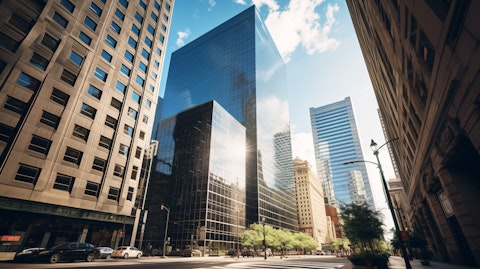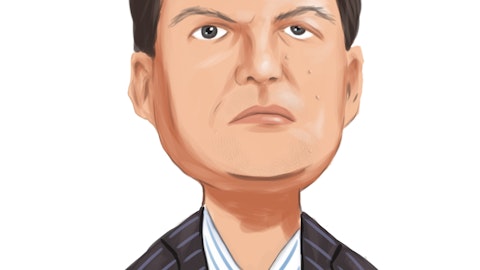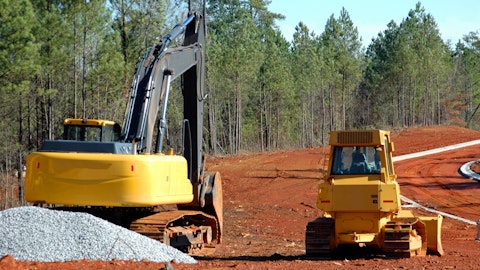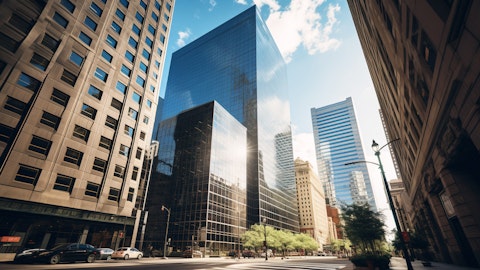Hudson Pacific Properties, Inc. (NYSE:HPP) Q4 2023 Earnings Call Transcript February 13, 2024
Hudson Pacific Properties, Inc. isn’t one of the 30 most popular stocks among hedge funds at the end of the third quarter (see the details here).
Operator: Hello, everyone. And welcome to the Hudson Pacific Properties Fourth Quarter 2023 Earnings Conference Call. My name is Emily, and I’ll be coordinating your call today. [Operator Instructions] I’ll now turn the call over to our host, Laura Campbell, Executive Vice President, Investor Relations and Marketing. Please go ahead.
Laura Campbell: Good morning, everyone. Thanks for joining us. With me on the call today are Victor Coleman, CEO and Chairman; Mark Lammas, President; Harout Diramerian, CFO; and Art Suazo, EVP of Leasing. Yesterday we filed our earnings release and supplemental on an 8-K with the SEC and both are now available on our website. The audio webcast of this call will be available for replay on our website. Some of the information we’ll share on the call today is forward-looking in nature. Please reference our earnings release and supplemental for statements regarding forward-looking information, as well as the reconciliation of non-GAAP financial measures used on this call. Today Victor will discuss our 2023 accomplishments and 2024 priorities along with macro trends across our markets.
Mark will provide detail on our office and studio operations and development. And Harout will review our financial results and 2024 outlooks. Thereafter we’ll be happy to take your questions. Victor?
Victor Coleman: Thanks, Laura. Good morning, everyone, and thanks for joining us. 2023 proved to be a challenging year as higher interest rates fueled recession fears and slowed the pace of office leasing across the country. Many industries, including tech, focused on cost cutting in part through layoffs and real estate downsizing. And while the nationwide office leasing activity improved incrementally in the fourth quarter, it remained about 10% below the five-year quarterly average. Furthermore, a once-in-a-generation dual studio union strike effectively shut down the entertainment industry. In Los Angeles, 2023 film and TV production in aggregate fell approximately 40% compared to the prior year, led by scripted TV, which fell close to 70%.
Against that backdrop and within our portfolio in many of the most impacted markets, our team has remained steadfast in our priorities to navigate these uncertain times. Aggressive leasing further strengthened our balance sheet in part through asset sales, executing our active development opportunities, as well as maintaining a leadership position in ESG. Specifically, we signed 1.7 million square feet of office leases in 2023, averaging over 420,000 square feet per quarter. We executed on over $1 billion of asset sales, which enhanced liquidity, allowing us to address our debt maturities until fourth quarter 2025 and improve our leverage metrics. We’re also on track to deliver our Sunset Glenoaks Studios and Washington 1000 development projects this quarter, and we received multiple ESG accolades.
All of this we accomplished while quickly pivoting to streamline studio operations and maximize non-production revenue during an historic strike. The Fed’s January commentary did little to encourage a major shift in corporate sentiment around office leasing, but we continue to observe a variety of trends in our core industries and markets that are favorable. In the fourth quarter, tech leasing rebounded to approximately 15% of all activity, up from 10% in the fourth quarter last year, but still 5% to 10% below pre-pandemic levels. In aggregate, tech layoffs appear to be slowing. Tech employment still exceeds pre-pandemic levels and is relatively strong compared to other industries. AI is in its early innings and has been an important driver of growth, comprising of around 40% of leasing activity in the San Francisco market in the fourth quarter.
In the years to come, we expect to see second and third waves of AI growth as big tech builds out their own teams and non-tech companies implement AI services, both increasing the demand for office space. Venture funding levels for the full year 2023 were in line with 2020 and are still strong. Most of the funding that has disappeared versus peak years of 2021 and 2022 is for very large deals, say $250 million plus, whereas smaller deals are only 25% off peak. And while tech has embraced the hybrid model, research indicates companies that are working on innovative, evolving technologies have a much stronger preference to be in the office. These are small- to medium-sized companies requiring 30,000 square feet or less that are growing and looking for space to support that growth.
This is our area of expertise in the Silicon Valley and a trend we should benefit from in our leasing tours and pipeline. Turning to our studio segment, following SAG’s contract ratification in December, production companies have been slow to green lit new productions. And in January, production counts remained approximately 20% below 2021 and 2022. Based on the level of activity we’re seeing real time; we now anticipate that production levels may not materially improve until the second half of the year. Media companies are still adjusting their business models through both revenue-generating and cost-saving measures, but original content remains integral to subscriber growth. And as an example, Netflix, one of our largest tenants, recently reaffirmed $17 billion of content spend for the year, which is in line with their 2021 and 2022 pre-strike spend.
On the transactions front, we successfully executed on three asset sales in the quarter, generating almost $890 million of gross proceeds. Most notable of these was our $700 million sale at approximately a 6% cap rate for our One Westside and Westside Two office redevelopment to UCLA, which we owned 7525 with Macerich. The fact that in the five years plus since acquiring this asset, we found not one but two high-quality, innovation-centric end users for this asset is a testament to our ability to identify and execute on unique opportunities and ultimately realize significant value for our shareholders. We’ll be working with UCLA on their build-out for certain elements of this project on a fee basis going forward. We also sold certain tranches of a loan secured by our Hollywood Media Portfolio for $146 million and a parcel of land in North San Jose for approximately $44 million.
All of these proceeds served to significantly enhance our leverage and liquidity position. We also received additional ESG recognition in the fourth quarter. We were named an Office Americas Sector Leader by GRESB for the third year in a row and for a second year in a row, NAREIT’s Leader of the Light for Office and one of Newsweek’s America’s Most Responsible Companies. Our focus on ESG continues to further differentiate our platform and assets while providing value for our tenants, our employees and our shareholders. At Hudson Pacific, we remain committed to our long-term strategy of optimizing our unique portfolio and platform to take advantage of future growth opportunities as they arise. In 2024, our priorities are fourfold, aggressive leasing within our office and studio portfolios, executing on opportunistic dispositions, successfully progressing our New York studio development, and further deleveraging and fortifying our balance sheet.
In so doing, as the next wave of growth takes hold, we will be well-positioned to leverage our portfolio, expertise and relationships to benefit our shareholders. Now I’m going to turn the call over to Mark.

Mark Lammas: Thanks, Victor. We signed 432,000 square feet of office leases in the fourth quarter, 75% of these were renewal leases and close to 65% of that activity was in the San Francisco Bay Area, including a 57,000 square foot renewal with GitHub at 275 Brannan. Our cash rents decreased just under 10% while GAAP rents decreased 2%, largely driven by two mid-size renewals in the San Francisco Bay Area, the expiring leases for which were signed at the top of the market. But for these two renewals, our cash rent spreads would have been flat. Our in-service office portfolio ended the year at 81.9% leased, with approximately 75-basis-point of 120-basis-point decrease between the third quarter and fourth quarter attributable to the sale of One Westside.
We are still seeing tour demand accelerate. During the quarter, we had over 145 tours, representing 1.4 million square feet of requirements, up 4% since last quarter and 50% higher than this time last year. Our leasing pipeline also remains active, with deals and leases LOIs or proposals totaling 1.9 million square feet, slightly below last quarter, but still up almost 6% year-over-year. In 2022 and 2023, we had an atypically high number of office leases expiring, largely the result of short-term renewal leases signed during the pandemic. We also had several large 100,000 square foot plus leases rolling. This year, we have a more manageable 1.5 million square feet expiring, which is aligned with our long-term average. This includes only one tenant and known vacate of just over 100,000 square feet expiring.
We currently have a variety of activity, that is deals signed in leases, LOIs, proposals or discussions on approximately 40% of that space, which is relatively on track for this time of year. Importantly, while we cannot control how and when demand will return, we remain confident in our portfolio along with our team’s ability to drive tour activity and execute on leasing in an effort to expedite closing timelines. That said, we are not banking on any material improvements in the operating environment this year. Our occupancy will likely be under pressure, at least in the first three quarters of the year, with a potential to return to essentially flat occupancy by year-end. This is based on both our historical leasing trends and informed directly by our team’s detailed space-by-space, lease-by-lease assessment of our portfolio and what we believe should be achievable.
Turning to our studios, on a 12-month basis, our in-service studios were 80.4% leased and our stages were 84.7% leased, with the change largely attributable to a single tenant giving back six stages in support space in the second and third quarters due to the strike. Our Quixote Studios and Stages were 29.3% and 30.1% leased, respectively, on a 12-month basis. In terms of our service business, in the fourth quarter, production resumed on certain of our long-term lease stages, which led to a 7% increase in combined lighting and grip, and other services revenue. We also grew our transportation revenue by approximately 10% from live events. Even as it’s taking time for shows to enter production, we have seen a pickup in demand. From December to January, we saw a 45% increase in studio tours and more than a doubling in stage-related inquiries.
Utilization across our transportation assets also picked up incrementally in January. Looking out over the next 90 days, 45% of our available stages are booked, which is a new high-water mark since the strike, following a multi-cam reality show taking all three stages at Quixote New Orleans. As for our in-process developments, Sunset Glenoaks is effectively complete and we are awaiting Department of Water and Power sign-off required for Certificate of Occupancy, which we expect to have next month. We pushed out our completion date to first quarter to reflect this updated timing. We are actively touring and engaging with an array of productions interested in either long-term or show-by-show leases. Construction continues at Sunset Pier 94, which will deliver year-end 2025 and we are in discussions with multiple tenants interested in long-term multi-stage leases.
As for our Washington 1000 development, we are finalizing FF&E and other marketing improvements as we await Certificate of Occupancy, which we also expect to receive next month. Large tenant demand in Seattle has yet to come back in a material way, but we are staying flexible and actively touring full-floor users. The building is stunning and we expect interest to accelerate once tenants can fully experience its impeccable design and fantastic indoor-outdoor amenities, especially vis-à-vis competitive product. And now I’ll turn the call over to Harout.
Harout Diramerian: Thanks, Mark. Our fourth quarter 2023 revenue was $223.4 million, compared to $269.9 million in the fourth quarter of last year. Mostly attributable to the sales of Skyway Landing, 604 Arizona and 3401 Exposition, previously communicated tenant move-outs at 1455 Market and 10900-10950 Washington, as well as a reduction in studio services and other revenue due to the related union strikes. Our fourth quarter FFO, excluding specified items, was $19.6 million or $0.14 per diluted share, compared to $70.2 million or $0.49 per diluted share in the fourth quarter last year. Specified items for the fourth quarter 2023 consisted of deferred tax asset write-off expense of $6.6 million or $0.05 per diluted share and transaction-related expenses of $0.2 million or $0.00 per diluted share.
Prior year specified items consisted of transaction-related expenses of $3.6 million or $0.03 per diluted share. Our fourth quarter AFFO was $21.5 million or $0.15 per diluted share, compared to $62.1 million or $0.43 per diluted share in the fourth quarter last year. Our fourth quarter same-store cash NOI was $116.1 million, compared to $127.4 million in the fourth quarter last year, with a change mostly attributable to the large vacate at 1455 Market and mid-sized tenant move-outs in San Francisco Peninsula and Silicon Valley, combined with a single tenant vacating stakes stages at Sunset Las Palmas during the strike. Note that our 2023 full year outlook assumed a 1.5% same-store cash NOI growth at the midpoint, including one west side which was sold five days prior to the end of the fourth quarter and where we experienced the full benefit of cash rents in 2023.
Our full year office same-store cash NOI growth would have been 3.8%. This also includes 170 basis points of growth attributable to the WeWork letters of credit, which we drew down in the fourth quarter and were not accounted for in our 2023 full year guidance assumptions. Turning to the balance sheet, following our $482.2 million mortgage loan refinancing at Bentall Centre with Blackstone and the full repayment of our construction loan from the sale of One Westside and Westside Two, we have no maturities until November 2025. Further, we use the net proceeds from One Westside and Westside Two, as well as the sales of Cloud10 and the Hollywood Media Portfolio to repay outstanding amounts under our unsecured revolving credit facility. As a result, we improved our share of net debt to undepreciated book to 36.5% and our share of net debt to EBITDA at 8.9%.
We finished the year with approximately $800 million in total liquidity comprised of approximately $100 million of cash and cash equivalents and $700 million of undrawn capacity under our unsecured revolving credit facility. The undrawn capacity of our credit facility reflects reduction under commitments to $900 million in association with favorable adjustments made to our related definitions and covenant calculations this quarter. We also have another approximately $200 million of undrawn capacity under our Sunset Glenoaks and Sunset Pier 94 construction loan. Now I’ll discuss our 2024 outlook. As always, this outlook excludes the impact of any potential dispositions, acquisitions, financings or capital markets activity or disruptions in studio operations related to an active strike.
We’re providing a first quarter and initial full year 2024 FFO outlook in the range of $0.15 per diluted share to $0.19 per diluted share and $1 per diluted share to $1.10 per diluted share, respectively. There are no specified items in connection with this guidance. We are introducing first quarter guidance to provide greater visibility around how our initial expectations for earnings and the early part of the year compare to our full year projections. More specifically, while we are seeing steady improvement in production activity since SAG’s contract ratification in December, most of the current activity relates to returning shows rather than new productions, the acceleration of which is an important driver of demand of our Quixote Studios and Services.
We expect new activity to continue to ramp up into the second half of the year, which should in turn contribute to steady improvement in our quarterly FFO outlook. Now will be how to take questions. Operator?
See also 25 Best Jobs That Can Make You a Millionaire Before Retirement and 15 Most Respected Countries in Asia.
Q&A Session
Follow Hudson Pacific Properties Inc. (NYSE:HPP)
Follow Hudson Pacific Properties Inc. (NYSE:HPP)
Operator: Thank you. [Operator Instructions] Our first question today comes from Alexander Goldfarb with Piper Sandler. Please go ahead.
Alexander Goldfarb: Hey. Good morning out there. Just two questions. First, a lot of us on the call clearly understand real estate. We don’t understand the movie business. So as we look at the guidance and the first quarter guidance, can you just help us understand the media walkthrough and the ramp? And then, Victor, to your point about the studios just taking a bit longer, is that — is there an assumption that that $100 million of NOI that you guys lost because of the strikes, that that will come back or is — meaning annualized this year or is that something that could get pushed out, the recovery of that $100 million could get pushed out to like 2026 or beyond?
Victor Coleman: So let me start with a generic, Alex. So thanks for the questions. And then I’ll let Harout jump in on the first part. We’ll walk you up the ramp a little bit. So our prepared remarks sort of indicated in the last quarter that we assumed when the strike was ending in November and then it wasn’t ratified till December, the production was ceased and desisted until January. The current state of affairs right now is, any production that was in filming is back up and running now. Anything that was green lit is now has to be green lit again and the timeline has been delayed because writers had stopped writing. They couldn’t write. And so we assumed that we would have a back end year and that’s been the assumption and how we’ve ramped you up to the second half of the year.
It may be second quarter, late second quarter. We were very comfortable, it can be third quarter and fourth quarter, and seasonality is not going to play as much of an issue going forward on that basis. In terms of $100 million. Yeah, we think we’re going to get there this year, but it could trickle through the first quarter. It’s clearly been January. The holds for the sound stages and the activity is there. The production is not even executed, because the script writing and other aspects around that have not been completed. We do think there are multiple holds are going to be executed for leasing and I think pretty much comfortable that how we’ve looked at this analysis being, this quarter is going to be low relative to the fourth quarter, which will be high.
That step up is exactly where we believe that it’s going to be. Harout, you want to walk through it?
Harout Diramerian: Sure. So, Alex, good question on the impact on the media, on our guidance. So, the media, specifically, Quixote and the timing around the activity there is contributing about $0.15 of our FFO. So meaning had that normalized quicker, we’d have $0.15 more of FFO, and you can kind of see that in our result of activity for the remainder of the year. We’re going from roughly a midpoint of $0.17 in Q1 to an average of, I think, almost $0.30 the rest of the year if you back into the number and that basically is the biggest drivers. Quixote as a result of, again, the slow ramp up of the studio business. I think if you normalize for that we’d be much more in line.
Alexander Goldfarb: Okay. And then the second question is, maybe Art can comment. The one of the positives are that we were hoping for this year. Last year, you guys were hit by Block, which was a big impact, we were big impact. This year, the granularity of the of the lease exposure was much smaller. I think the biggest one was like 90,000 and then 80,000 and then it dropped off precipitously. So it’s much more smaller impact. Based on your leasing comments that, occupancy could decline through the third quarter. That leasing — tech leasing is still tepid. Do we still have comfort or do you guys still have comfort in the granularity of this year’s lease exposure that we won’t really see big impacts the way we did last year or are you viewing that, the lease exposure this year, while smaller tenants could — we could end up with sort of the same treasury, if you will, this year that we saw last year?
Mark Lammas: Alex, this is actually Mark, because those are my comments as it related to softness in the first part of the year. I’ll just give you a little bit of color around that, and then, Art, art can comment on status of some of the upcoming expirations. But, yeah, so our own expectations is that, for the first half of the year, we’re likely to see a bit of softness on our occupancy levels relative to where we ended the year with steady improvement in the back half of the year. Just to put a finer point in terms of what that boils down to in terms of numbers. If you take our 12/31/23 expirations together with our schedule, there are 24 expirations, about a 107 million feet of total expirations. If you take, say, 40% retention on that would be — which would be a historically conservative amount.
We typically retain better than that amount. But if you took 40%, it’s about 700,000 feet of that. We’ve already executed 75,000 feet of that. That leaves us about a 1 million feet of leasing to do on existing availability. We’ve already executed about 160 of that. So that leaves you about 840,000 to spec new leasing on existing availability. It’s fairly — to get back to where we ended the year on occupancy. So 840 is a fairly high level of activity. As we indicated in our prepared remarks, the team is — as we do every year heading into year end, we do a very, very detailed, deep dive into every asset, every available space. And as we said today, we think that number is achievable, which is why we commented in our prepared remarks that, we think it’s a good site to get back to year end 2020 — 20/31/23 occupancy by end of this year.



